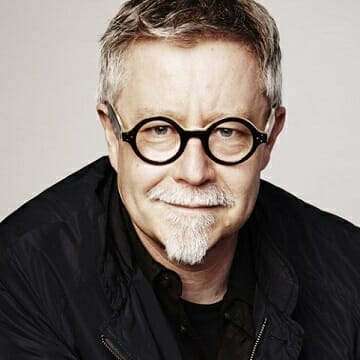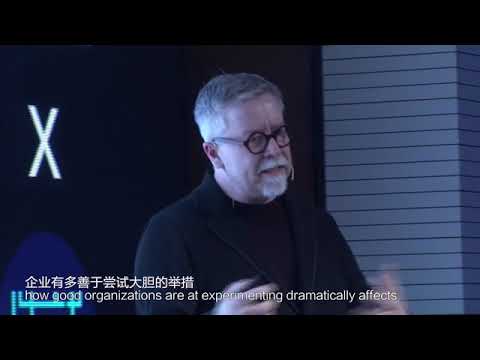Videos
Learn More About Tim Brown
Why do some innovations succeed while other seemingly brilliant ideas fail? For decades, world-renowned industrial designer Tim Brown has been helping organizations address this key question.
According to Brown, traditional approaches to designing a new product, service or program often fail to see the big picture. By moving from traditional design methods to “design thinking” – a holistic, collaborative, human-centered approach – success is much more likely and the impact is more widespread.
Brown’s unique expertise is at the intersection of design, science, technology and the arts. For over two decades, he has been teaching organizations how to innovate better by looking beyond the design itself to its potential for improving the human experience and for solving big problems. Though it has been around for some time, many organizations still don’t know what design thinking is, which says a lot about how much has “changed” around innovation in the last few decades.
“Design thinking draws its strength from democratizing the design process, from putting the tools of design into the hands of as many diverse people as possible,” says Brown, co-chair of the global design firm IDEO, where he also served as President and CEO from 2000 to 2019. “It’s about multi-disciplinary groups of thinkers coming together to tackle problems (some that may not yet be obvious), to collectively consider all possibilities and solutions, and repeatedly refine.”
As a leading voice for solving global and organizational problems through design thinking and design collectivism, Brown advises senior executives and boards of global Fortune 100 companies and frequently speaks about the value of design thinking, creative leadership and innovation. His critically acclaimed 2009 book, “Change by Design: How Design Thinking Transforms Organizations and Inspires Innovation” challenged existing models and the concepts laid the foundation for the way he works with clients today.
Brown – who attended the Royal College of Art, fabled incubator for artists like David Hockney, James Dyson, Ridley Scott and Tracey Emin – was one of the early drivers of the design thinking movement. In 1982, a UK design magazine published his article “The Future of Design” in which he shared his paradigm-shifting ideas, and today he admits that while his thinking has evolved, the core ideas haven’t changed much.
According to Brown, one of the many benefits of design thinking is that it helps companies avoid missed opportunities and costly failures. In both business and social sectors, Brown has seen too many initiatives falter because they were not based on the end user’s needs, not prototyped to solicit feedback, and/or they suffered from incorrect preconceived notions. With its human-centered framework for developing new ideas, design thinking is an antidote to such outdated approaches.
The elements of empathy around design thinking make it particularly relevant today as organizations increasingly rely on AI to make key decisions. Brown teaches strategies for designing products, services, programs and business models that leverage technology for human benefit, rather than vice versa. Increasingly, his desire to use design thinking to build pathways has him tackling big social problems as well, with positive and far-reaching results.
“Design thinking relies on our ability to be intuitive, to recognize patterns, to construct ideas that have emotional meaning as well as being functional, and to express ourselves in media other than words or symbols,” says Brown. “Nobody wants to run an organization on feeling, intuition, and inspiration, but an over-reliance on the rational and the analytical can be just as risky. Design thinking, the integrated approach at the core of the design process, provides a third way.”
Currently working with his own team to collectively find solutions to the COVID-19 crisis and other global problems, Brown is encouraged by mounting evidence that shows the more people participate in the creation of new systems and solutions, the more likely they are to change behaviors in order to support them.
Tim Brown, co-chair of IDEO, has earned numerous design awards and has exhibited work at the Axis Gallery in Tokyo, the Design Museum in London, and the Museum of Modern Art in New York. He takes a special interest in the convergence of technology and the arts, as well as the ways in which design can be used to promote the wellbeing of people living in emerging economies. He speaks about the value of design thinking, creative leadership and innovation to business leaders and designers around the world. Brown participates in the World Economic Forum in Davos, Switzerland, and his talks Serious Play and Change by Design appear on TED.com.
In addition to advising senior executives and boards of global Fortune 100 companies, Brown serves on the board of directors of Steelcase Inc. and is a member of the board of trustees of IDEO.org. In addition, he is a member of the board of advisors for the World Economic Forum Center for the Fourth Industrial Revolution and writes for Harvard Business Review, The Economist and other prominent publications.
Brown holds honorary doctorates from The Royal College of Art (London), Keio University (Tokyo), Claremont McKenna Graduate University (Los Angeles) and Art Center College of Art and Design (Los Angeles). He maintains a blog, designthinking.ideo.com/blog, and contributes as one of LinkedIn’s original top 150 Influencers. He is also an instructor for the IDEO U Leading for Creativity course.
Tim Brown is available to advise your organization via virtual and in-person consulting meetings, interactive workshops and customized keynotes through the exclusive representation of Stern Speakers & Advisors, a division of Stern Strategy Group®.
Design Collectivism for Solving Big Problems: The Next Step in Democratizing Design
For decades, we’ve seen many of our societal systems fail, mainly because they were designed for another time when the industrial revolution encouraged mass production and consumption to support a consumer economy. Not only are these systems fraying around the edges as they run up the limits of our resources, but we are also discovering – especially during the pandemic – that they were not working that well anyway. The only way forward is for organizations to redesign and retool to create a sustainable future. Fortunately, there are technologies that can assist in that process. Block chain, smart contracts and distributed web technologies allow teams to not only share work but share the ownership and outcomes of work, and even create whole economic systems that increase the value for the people who participate. Renowned industrial designer and co-chair of IDEO Tim Brown calls this “design collectivism.” Through keynotes, workshops and advisory roles, Brown shows organizations how to develop “design collective” business models and practices that support long-term growth and sustainability. In addition to making organizations more agile, adaptable and productive, design collectivism also increases positive brand recognition. Brown sees it as a particularly useful model for health care organizations and foundations like the Red Cross who regularly develop integrated response plans, some on a global level.
How Creative Competitiveness Fuels Sustainable Growth
While many organizations have high levels of efficiency, most have relatively low levels of creative competitiveness, a term renowned industrial designer and IDEO co-chair Tim Brown uses to describe an organization’s capacity to come up with, act on and spread new ideas. Realizing organizations must reach far beyond R&D when it comes to innovating, Brown shows leaders how to build more creative practices into their organization. In keynotes, workshops and advisory roles, he teaches design thinking methods to innovation teams so they can make the most effective use of creative practices in order to gain a competitive edge into the future.
Change by Design: How to Transform Your Organization and Inspire Innovation
Though change has always been necessary for organizations, the recent acceleration of trends, including artificial intelligence (AI) and machine learning, have made the need to adapt and rethink strategy more pressing than ever before. Over a decade ago, renowned industrial designer and co-chair of IDEO Tim Brown began focusing on the power of “design thinking,” a method of innovation by which human needs form the basis of creative problem solving, innovation and decision making. According to Brown, prioritizing human needs and experiences is even more important today as AI and machines are increasingly involved in decision making. Drawing on his decades of experience as a designer, teacher, collaborator and author, and on the concepts outlined in his acclaimed book “Change by Design,” Brown shows audiences how to strategize around empathy to design products, services and business models that leverage technology for human benefit, rather than vice versa. In a time of uncertainty about where technology will take us, Brown’s human-centered design thinking offers dynamic innovators across industries strong, stable footing.
How to be a Creative Leader
Traditionally, leaders were expected to have all the answers. But in an era of rapid change, leaders must increasingly rely on the creative input of others, whether fellow executives or people in the organizational hierarchy. To develop truly innovative solutions, they must challenge their own assumptions about what works best, remaining open to unorthodox and even counterintuitive proposals. In this presentation, co-chair of IDEO Tim Brown draws on his design thinking framework to show 21st century leaders how they can transition from a leader-knows-best approach to creating organizations that ask questions and experiment with new ideas to solve problems and deliver better results. Leaders must, says Brown, play the alternating roles of “the explorer, the gardener and the player-coach,” engaging with team members, cultivating creativity and daring to take risks.
Minimize Waste, Maximize Profit: Redesigning Your Organization for the Circular Economy
The economy created by the industrial revolution was essentially “linear” – raw materials were extracted from the earth, products were made from them and what remained was discarded. Unfortunately, too much of this linear approach still exists in a world rapidly being destroyed by waste and excess. To save the planet, we will need to overhaul our entire economy, moving from linear to “circular:” the minimization of waste and maximization of all our existing resources. This requires a new industrial revolution, and co-chair of IDEO Tim Brown argues that design thinking will play a leading role in generating the innovations necessary to make this transition. In this presentation, Brown draws on his “Circular Design Guide” to show how the design thinking principle of putting human problem-solving at the center of innovation can help organizations power the shift to a circular economy. Those who embrace these challenges now will, says Brown, come out on top in a new business model that is worth a trillion dollars, and destined to reshape the way businesses and consumers alike think about our economic system.
For Design, “Empathy is Not the End, It’s the Means”
March 5, 2019
What’s the Secret to Great Design? Finding the Right Verb. (Really.)
February 19, 2019
How Great Design Could Fix the World's “Wicked Problems”
February 15, 2019
How to Solve Problems Like a Designer (video)
September 21, 2017
Praise for “Change By Design”
“Brown writes with a winning combination of thoughtfulness, pragmatism and enthusiasm… He avoids the trap of presenting design thinking as a panacea. Mr. Brown charts its failures as well as successes…”
“It’s like getting golf tips from Tiger Wood’s coach. Tim Brown’s firm IDEO has won more medals for innovative design than anyone in the world. If you want to be more innovative at work or in life, study with the coach of champions.”
“In his new book, the CEO of design shop IDEO shows how even hospitals can transform the way they work by tapping frontline staff to engineer change.”
“This should be mandatory reading for marketers and engineers who can’t understand why a product as cool as the Segway wasn’t a breakout hit.”
“Tim Brown has written the definitive book on design thinking. Brown’s wit, experience, and compelling stories create a delightful journey. His masterpiece captures the emotions, mindset, and methods required for designing everything from a product, to an experience, to a strategy in entirely different ways.”
“With people like Brown codifying design thinking, the tools are out there to solve our problems if a few people are willing to attack them with that sort of tenacity.”
“Tim Brown’s vision, intellect, empathy and humility shine through every page of this book. Change by Design is for dreamers and doers, for corporate executives and NGO leaders, for teachers, students and those interested in the art of innovation.”
“Design thinking… is a way of seeing the world and approaching constraints that is holistic, interdisciplinary, and inspiring.”
“Brown is clear, persuasive, and often funny… Even for those of us without our own sovereign nation or blue-chip corporation, design thinking offers a guide for rethinking and organizing our everyday creative processes.”
“Brown makes a potent case for employing this creative collaboration in a variety of settings.”


























